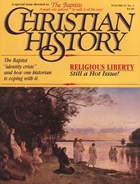1509–1547 King Henry VIII
The Pope’s refusal to annul the marriage of Henry and Katherine of Aragon leads to separation of English Church from Rome.
1534 Act of Supremacy declares Henry “… the only supreme head in earth of the Church of England.”
Tyndale’s Bible, the first English translation to be printed, placed in every church.
Henry dissolves monasteries and annexes their revenue to the state. The Ten Articles (1536) include reference to the authority of the Scripture and justification by faith but much of the Roman faith remains, including prayer to departed saints, concepts of purgatory, transubstantiation and celibacy of clergy.
1547–1553 King Edward VI
Changes begun under Henry are realized: images removed from churches, devotional life stressed, marriage of ministers legalized, priests become ministers.
Thomas Cranmer’s prayer books (1547, 1552) provide major theological reforms in worship.
Parliament takes responsibility for Book of Common Prayer and the King issues the official doctrinal position of the Church of England.
1553–1558 Queen Mary
Mary attempts to restore Roman Catholicism to England.
Cranmer and other Reform leaders burned at Oxford.
Exiles from England in Geneva and Strassbourg influenced by Calvinistic Puritanism and other Protestant principles.
1558–1603 Queen Elizabeth
Catholicism again rejected and Romanizing bishops deposed. Cranmer’s Book of Common Prayer reinstated and all clergy required to subscribe to the Thirty Nine Articles of the Church of England.
Puritans emerge among the returned Marian exiles striving to “purify” church life and establish patterns in accord with Scripture. The Puritans seek to reform the church from within along Calvinistic Presbyterian lines.
Another grouping called “Separatists” see no hope of adequate reform for the church from within and separate to set up their own congregations. They call for a believers’ church membership and are the forerunners of the congregationalist style churches. The Separatists are persecuted and some of their leaders hanged in 1593.
1603–1625 King James I
Hopes rise among the Puritans that this Scottish King will introduce Presbyterianism into the English church but James will have none of it declaring “A Scottish Presbytery as well agreeth with the monarch as God and the Devil.”
300 Puritan clergy are ejected from parishes in the opening years of James’ reign.
The first Baptists appear among the Separatists, led by John Smyth and Thomas Helwys.
Copyright © 1985 by the author or Christianity Today/Christian History magazine.
Click here for reprint information on Christian History.

Support Our Work
Subscribe to CT for less than $4.25/month





























